Tattoo After-Care: Your Full Guide To The First 48 Hours
Tattoo After-Care: Your Full Guide To The First 48 Hours
Proper tattoo after-care is essential for skin health and the look of your fully-healed tattoo. While a form of self-expression, a fresh tattoo is no different from an open wound. Tattooing involves needles, blood, and other bodily fluids like any minor medical procedure. The tattoo needle temporarily damages the skin barrier, triggering the body’s wound-healing response. Your skin begins to repair itself immediately. However, it takes around one week for scabs to form to protect the area from germs, moisture, and other potential irritants.
How you care for a new tattoo during the first 48 hours is crucial for proper healing. During this initial after-care stage, you must keep your fresh ink clean, covered, and protected. Always follow your artist’s exact tattoo after-care instructions. Never try to cut corners on the timeframes they provide to you, or, improvise. Make sure to do your research to find the best artist you can afford in your area. The best after-care starts before sitting in the studio chair.
There are some general guidelines and best after-care practices to follow throughout the different tattoo healing stages. Keep in mind that every healing journey varies to an extent – depending on the tattoo placement, size, and ink colour.
Here’s the ultimate guide on caring for your tattoo for the first 48 hours with important information on when to take off the bandage, the best products to use, what to avoid, and other essential after-care instructions.
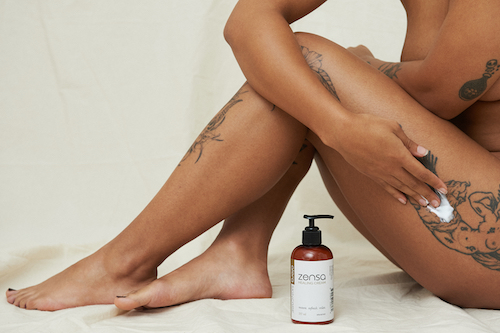
The First 48 Hours Overview
During this stage of the tattoo after-care process, the goal is to keep the tattoo as sterile as possible while still allowing the wound to breathe. You need to remove the tattoo bandage, clean the tattoo, and have freshly-washed linens on hand to minimize the risk of infection. The first stage of the tattoo healing process will involve some blood and weeping (plasma) drainage. So, be prepared to have some clothing or bed sheets you’re willing to toss after their next use. Have mild skincare products and plenty of paper towels on hand. Wearing loose clothing is highly recommended to give the fresh ink some air (and gives you a good reason to enjoy the extra comfort).
What To Do (And Expect) For The First 24 Hours
Your tattoo artist will wrap your tattoo immediately after finishing the piece. This bandage should be left on anywhere between 3 and 24 hours after getting your tattoo – depending on the bandage used and the size of your piece. Tattoo bandages often come off before going to bed the first night. Usually, you should remove your tattoo bandage after 3-4 hours. Carefully wash your new tattoo with a professional tattoo cleanser or mild antibacterial soap and lukewarm water. Pat it dry with a fresh paper towel. Always wash your hands before cleaning or touching any skin near the fresh tattoo.
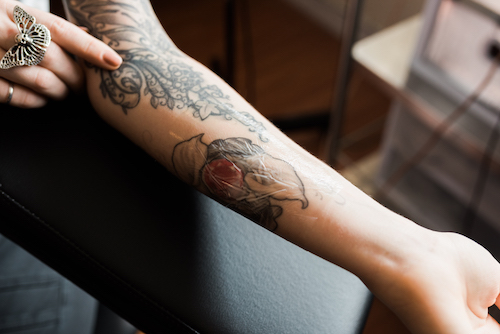
You can leave your tattoo wrapped for the first night if you use certain types of medical-grade protective film. However, you will need to change it if too much fluid builds up. Some artists recommend rewrapping your tattoo before bed to prevent stains. Listen to your artist’s guidance. Factors like the size and placement of your tattoo help determine whether rewrapping your tattoo is the best decision during the early after-care stages.
Wait at least 3-4 hours to shower after getting your tattoo. Make sure that the water is lukewarm and use a clean towel to dry off. Any fabric that could touch your skin (towels, sheets, shirt, sweatpants, etc.) should be fresh out of the wash. Prepare to ruin your sheets and pajamas during the first 24-48 hours. There’s always a chance that plasma, blood, or excess ink create an impressionable stain.
Keep an eye on the area to ensure you see no signs of infection. Make sure no foreign objects (pet hair, dirty linens, etc.) come into contact with your new tattoo.
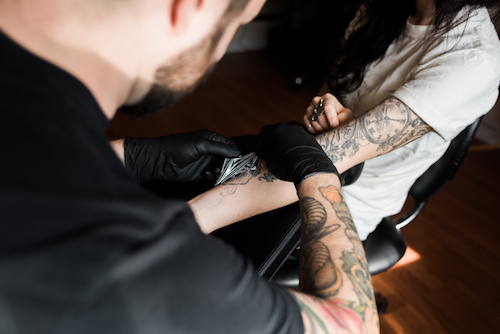
How Long To Keep Your Tattoo Wrapped
Protective tattoo film is widely considered preferable to cling wrap. Many artists recommend never using saran wrap on a new tattoo. Using saran wrap on a fresh wound is a health hazard (despite this method being used for decades). Products like Saniderm or Dermshield are breathable, flexible, and can be worn in the shower. However, you need to regularly monitor your wrapped tattoo to see if fluid builds up and the skin needs cleaning. While every piece will differ, many tattoo wraps need to be changed at least once every 24 hours for the first 1-3 days. Wash your tattoo as needed or at least once a day during this initial healing stage.
The Next 24 Hours
Your tattoo will likely still be sore. The area often appears swollen and red – similar to a sunburn.
Remove the protective tattoo wrap if you didn’t let the tattoo air dry. With clean hands, wash your tattoo with the same gentle tattoo cleanser or antibacterial soap and lukewarm water. Gently pat it dry with a fresh paper towel. After 24 hours, it’s time to start moisturizing your tattoo. Always use a fragrance-free lotion.
Tattoo lotions, like Zensa Healing Cream, or a hydrating ointment like Aquaphor (for a more affordable choice) are great options. Apply a thin layer of moisturizer with every use. You can use it more frequently if needed.
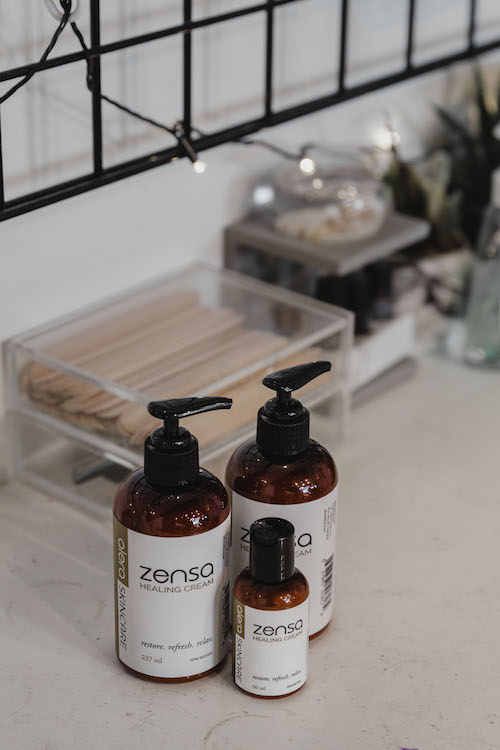
If recommended, you can rebandage your tattoo with medical-grade tattoo film. Let it air dry otherwise. Wash and moisturize your tattoo 2-3 times a day. As always, follow your artist’s after-care instructions for your unique piece.
By the second day, your tattoo starts to have a cloudy appearance. Scabs should begin forming within the first 48 hours or by day 3. Continue to monitor the tattoo for any signs of infection or scarring (especially if you feel physically ill).
Best Tattoo After-Care Practices
The best tattoo after-care practices support internal and external healing. Keep the tattoo clean and unbothered. Nourish your body so it can rest and recover. Regularly wash and moisturize your tattoo (without overdoing it). The skin needs to stay hydrated to repair the skin barrier and support the wound-healing process. Zensa Healing Cream contains medicinal-grade calendula oil and grapefruit oil for anti-inflammatory and skin hydration benefits, like reducing irritation and speeding up tattoo healing. Its other nourishing ingredients include shea butter, cucumber extract, and aloe vera to moisturize and soothe the skin. Zensa Healing Cream also contains sunflower seed oil to brighten and preserve the tattoo’s colour without impeding ink settling.
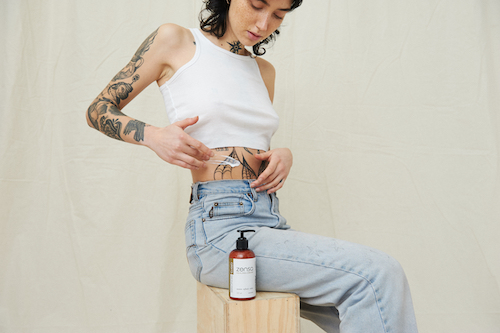
Keep the skin dry, and ensure nothing rubs against the wound. Wear loose-fitting clothes in breathable fabrics like cotton, rayon, silk, linen, or bamboo. Change clothes immediately if you start to feel sweaty.
Drink plenty of water. Incorporate vitamin C-rich and anti-inflammatory foods, like oranges, berries, spinach, broccoli, tomatoes, ginger, garlic, and dark chocolate into your diet. These nutrients will help prevent dehydration, fight bacteria, and provide antioxidants to aid your wound-healing journey.
What To Avoid During The First 48 Hours
Avoiding moisture is essential during the tattoo healing process, especially for the first 48 hours. Excess moisture invites more opportunities for dirt, bacteria, and other microbes to irritate the wound, which could lead to infection, scarring, or premature tattoo fading.
Stay out of the rain when leaving the studio with your fresh tattoo. Don’t let your tattoo soak in water when cleaning or let it submerge in the shower. Avoid sweating during the healing process. Don’t participate in any intense exercise for at least 48 hours after getting a tattoo.
Never use harsh soaps or any skincare products containing fragrances or chemicals. Avoid direct sunlight. Don’t apply sunscreen directly on a tattoo until it’s fully healed (4-6 weeks).
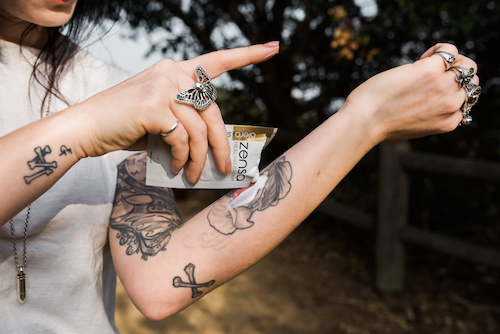
Always cover your tattoo under loose clothing before going outside. Never wear tight clothes, like fitted shirts or skinny jeans, over a fresh tattoo. Avoid wearing clothes made with nylon, polyester, or wool. Let your tattoo air out when inside. Wear shorts, tank tops, or go barefoot when possible – depending on the placement of your tattoo.
Avoid sleeping directly on your tattoo and using any slept-on sheets. Previously-used bath or face towels should also never touch or go near a fresh tattoo.
Don’t drink any alcohol for at least 48-72 after (and before) getting a tattoo. Alcohol thins your blood, which can lead to excess bleeding.

The Next Healing Stages
It is normal to feel slightly under the weather for the first 48-72 hours after getting a tattoo. After around 72 hours, you should start to feel better and enter a new stage of the healing process. On day 3, expect your tattoo to have a cloudy appearance from scab formation. This is a sign that your skin is repairing itself. The bleeding and drainage should subside by day 3 or 4.
For days 4-7, scabs should continue forming and thicken over your tattoo. Make sure to be diligent about your after-care routine during this first week. Wash, pat dry, and moisturize the tattoo once or twice daily. The following healing stage often starts during days 7-14 of the tattoo healing process. Your tattoo will peel from around day 7 to 2 weeks after getting your tattoo. During the peeling stage, it is normal for your skin to feel dry and itchy. Resist the urge to scratch and make sure your skin is well moisturized.
Tattoo lotions, like Zensa Healing Cream, are designed to reduce itching, minimize scarring, infection, and tattoo fading or patchiness.
Never pick, peel off, or scratch your scabs throughout the healing process. Picking at scabs on a new tattoo can pull the ink out and lead to a patchy tattoo, scarring, a reopened wound, or potential infection. After 2 weeks, the dead skin cells should exfoliate themselves away to unveil a fresh layer of healed skin. Your tattoo should be fully healed after around 4-6 weeks.
Read more about what to expect during the tattoo after-care process day by day.
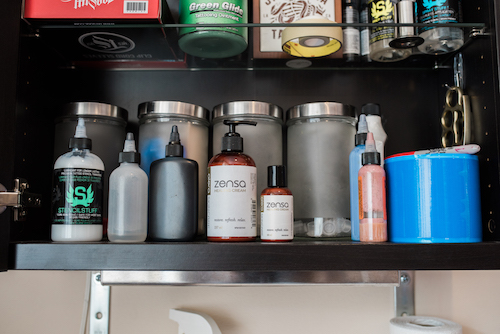
Tattoo After-Care FAQs:
How Can I Speed Up My Tattoo Healing?
Proper tattoo after-care is the best way to accelerate tattoo healing and desired results once your tattoo fully heals. Stay consistent with the basics. Remove the tattoo bandage on time, wash and moisturize the tattoo daily, keep it dry, let the fresh wound breathe, and avoid direct sun exposure.
How Often Should I Wash My Tattoo?
Wash your tattoo 2-3 times a day. If you’re keeping your tattoo wrapped for a few days, you might only need to wash it once a day. Ask your tattoo artist for personalized after-care instructions.
What Happens If You Don’t Moisturize A New Tattoo?
Dry healing is a tattoo after-care method that relies on the tattoo to heal itself from being exposed to the air without using other after-care products or practices. Not moisturizing a new tattoo can lead to side effects like cracking, irritation, and infection. It can increase the tattoo’s itchiness and urge to scratch. Without using lotion on your tattoo, you’re more likely to end up with a patchy or prematurely faded tattoo. Proper hydration is essential to rebuild the skin barrier and encourage wound healing. Be mindful of the tattoo lotion or moisturizer you choose. Always ensure that your hydrating product is fragrance-free, gentle on the skin, and approved by your artist to use on your tattoo.
Can You Over Moisturize Your Tattoo?
There can be too much of a good thing, especially when using too much lotion on a new tattoo. Over-moisturizing a fresh tattoo can clog your pores, increase the risk of irritation or infection, and lead to breakouts on the wound. Excess moisture also creates a breeding ground for germs, oil, and bacteria to get into the broken skin. This infection can inflame the wound and can affect the ink colour’s vibrancy, lead to premature fading, a patchy tattoo, or more serious skin health issues.
Always apply a thin layer of tattoo lotion to avoid over-moisturizing. Wipe off any excess product and let the lotion soak in before thinking about using more. Apply your moisturizer 2-3 times a day to maintain a happy medium and keep your tattoo hydrated.
